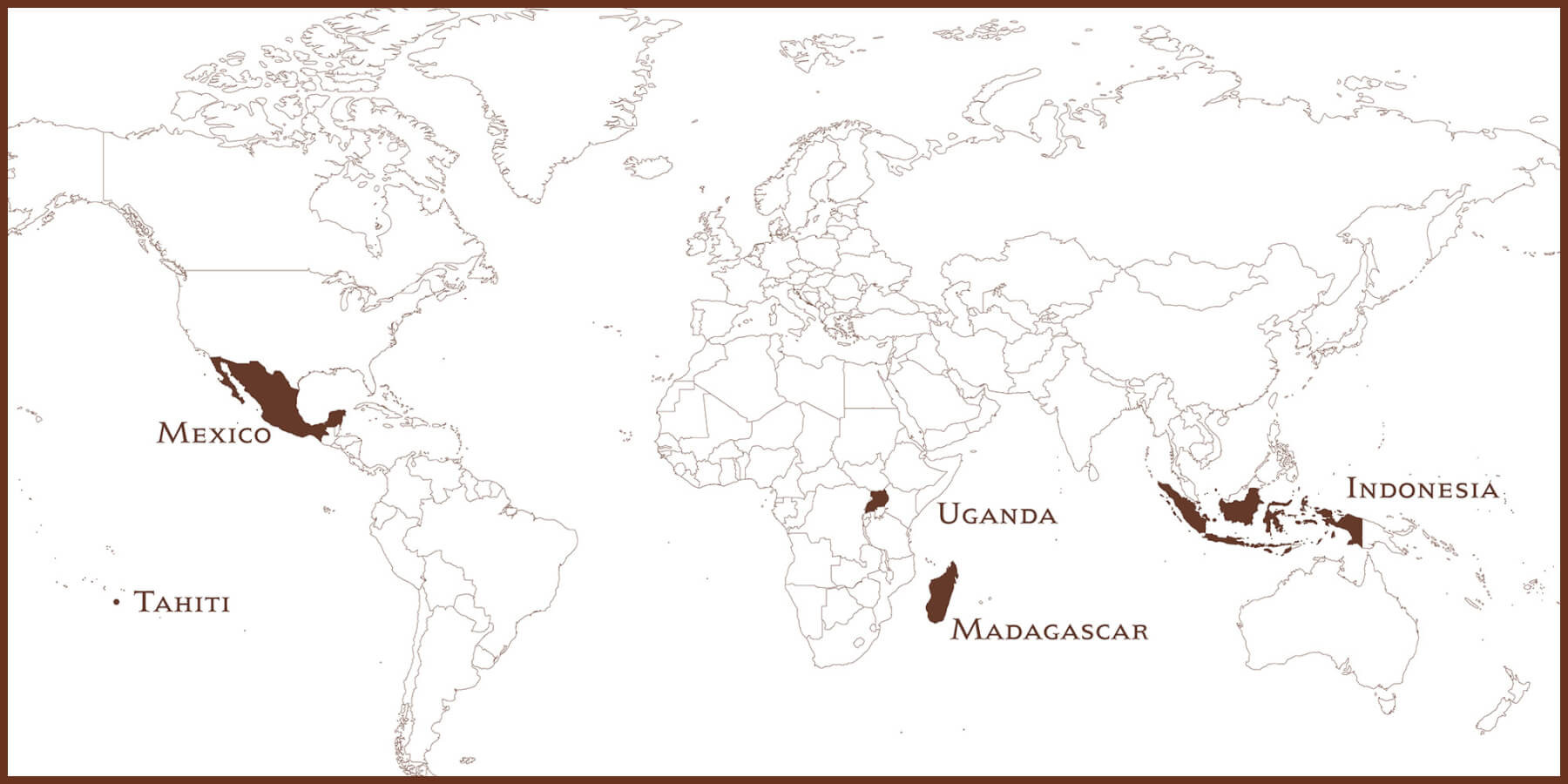Vanilla, a flavor cherished globally, graces everything from our morning coffee to decadent desserts. Its rich, aromatic profile is instantly recognizable, yet the journey of vanilla from its origin to our kitchens remains a mystery for many. Where does this beloved spice actually come from?
Vanilla beans are cultivated in a specific geographical band, thriving within 10 to 20 degrees of the equator. This tropical sweet spot provides the ideal climate for the vanilla orchid to flourish. Today, the majority of vanilla beans originate from a few key regions, most notably Madagascar, Mexico, and Tahiti, each imparting a unique character to the final product.
 Where Does Vanilla Grow World Map
Where Does Vanilla Grow World Map
The origin of vanilla significantly influences its taste. Similar to fine wines, artisanal chocolates, and gourmet coffees, vanilla beans absorb nuances from their environment. Factors like climate, soil composition, specific curing methods, and even the vanilla species itself contribute to a distinct flavor profile characteristic of each growing region. For example, Madagascar vanilla is celebrated for its creamy and sweet notes, while Mexican vanilla offers a spicier edge alongside its sweetness, and Tahitian vanilla stands out with its fruity and floral aroma.
Let’s embark on a global exploration to uncover the primary regions where vanilla is cultivated. While vanilla enjoys worldwide popularity, its cultivation is limited to a select few countries. We will delve into five prominent vanilla-growing regions: Mexico, Madagascar, Tahiti, Indonesia, and Uganda, to understand what makes each origin unique.
Mexico: The Historical Birthplace of Vanilla
Mexico holds the esteemed title of vanilla’s birthplace. The Vanilla planifolia Andrews orchid, the source of what we know as vanilla, is indigenous to Mexico. For centuries, the secrets of vanilla cultivation were closely guarded by the native Totonac people. Later, the Aztecs inherited this precious knowledge after conquering the Totonacs. The arrival of Hernán Cortés and the fall of the Aztec empire marked a turning point, as vanilla pods were introduced to Spain, opening up this exquisite flavor to the wider world.
Interestingly, for nearly three centuries, Mexico remained the sole source of vanilla beans. This exclusivity was largely due to a unique symbiotic relationship between the vanilla orchid and a tiny bee native to Mexico, the Melipona bee. This particular bee is the only insect naturally evolved to effectively pollinate the vanilla orchid flower, a crucial step in vanilla bean production.
Vanilla beans begin their life cycle as green pods on a vine. Harvesting occurs when the tips of these green beans just begin to hint at yellowing. However, the curing process is where the magic happens. It is during curing that the beans develop their signature brown hue, along with their complex flavor and captivating aroma. The Mexican curing process involves a traditional approach. Vanilla beans are carefully wrapped in blankets and straw mats and then placed inside ovens for a period of 24 to 48 hours. Following this initial heat treatment, the beans are laid out daily under the sun to absorb warmth, and then gathered into large wooden boxes overnight to encourage sweating. This cycle of sun exposure and sweating continues. Once the beans are properly cured, they are arranged on racks and placed in conditioning boxes for further flavor development and mellowing. This entire curing process is remarkably labor-intensive and can span from three to six months.
Tasting Notes: Mexican vanilla presents a compelling flavor profile – a rich blend of sweet and woody notes underscored by a deep, spicy character reminiscent of clove or nutmeg.
Try It Now: Mexican Pure Vanilla Extract Buy Now
 Where Does Vanilla Grow World Map
Where Does Vanilla Grow World Map
Alt text: Map highlighting Mexico as a key vanilla growing region, emphasizing its historical significance as the birthplace of vanilla.
Madagascar: The Hand-Pollination Innovation for Vanilla
Madagascar, an island nation situated east of southern Africa, is part of the Bourbon Islands group. This group also includes Réunion, Mauritius, Comoro, and Seychelles. Therefore, the term “Madagascar Bourbon vanilla” refers to its regional origin within the Bourbon Islands and not to any association with bourbon liquor.
The story of vanilla cultivation in Madagascar began around 1793 when a vanilla vine was smuggled from its native Mexico to Réunion Island. However, for nearly fifty years following its arrival, vanilla production faced significant hurdles. The vines thrived, producing beautiful blossoms, but rarely yielded vanilla pods. The critical missing piece was the Melipona bee, vanilla’s natural pollinator in Mexico. Local insects could only occasionally achieve pollination.
A breakthrough arrived in 1836 when Charles Morren, a Belgian botanist, identified the crucial link between the Melipona bee and vanilla pollination. Building on this understanding, in 1841, Edmond Albius, residing in Réunion, ingeniously developed an efficient technique for hand-pollinating vanilla flowers. This innovation proved transformative. Hand-pollination was eventually refined and implemented on a commercial scale. Growers could now selectively pollinate the most promising flowers and optimize their spacing on the vine, resulting in healthier and superior quality vanilla pods.
Coupled with Madagascar’s favorable hot, humid climate and fertile soil, the widespread adoption of hand-pollination by the island’s skilled and patient farmers catapulted Madagascar to its current status as the world’s leading vanilla producer, both in terms of quantity and consistent high quality.
In Madagascar, the curing process shares similarities with the Mexican method, but with a subtle yet important variation. Malagasy vanilla farmers initiate curing by briefly immersing the green vanilla beans in hot water. Following this blanching step, the beans are placed in sweat boxes before commencing the now-familiar routine of sun-drying during the day and wrapping them away overnight. This distinct curing process, combined with the unique growing conditions of Madagascar, contributes to the development of the renowned, rich, and exceptionally complex flavor profile that defines Madagascar vanilla.
Tasting Notes: Vanilla from Madagascar is characterized by its sweet, creamy, and smooth flavor.
Try It Now: Madagascar Bourbon Pure Vanilla Extract Buy Now
 Where Does Vanilla Grow World Map
Where Does Vanilla Grow World Map
Alt text: Madagascar highlighted on a world map, showcasing its position as the world’s top vanilla producer due to hand-pollination techniques and ideal climate.
Tahiti: A Unique Vanilla Species and Distinct Curing
Tahiti, a picturesque island nestled in the South Pacific, boasts a tropical climate perfectly suited for vanilla cultivation. In 1848, French Admiral Ferdinand-Alphonse Hamelin introduced Vanilla aromatica plants to Tahiti. Two years later, French Admiral Louis-Adolphe Bonard further expanded Tahitian vanilla varieties by importing Vanilla fragrans plants. Over the subsequent decades, skillful crossbreeding of these two species led to the emergence of the plump and fragrant Tahitian vanilla beans we recognize today – Vanilla tahitensis.
Tahitian vanilla undergoes a curing process that diverges from the methods employed in Madagascar and Mexico. Mature Tahitian vanilla beans are initially stacked in a cool environment for five to ten days, allowing them to turn completely brown. Uniquely, they are then rinsed in clear water, a step specific to Tahitian vanilla curing. Next, over approximately a month, growers expose the beans to the gentle morning sun for three to four hours daily. In the afternoon, the beans are wrapped in cloth and stored in crates until the following morning to promote transpiration. This cycle facilitates gradual water evaporation, causing the beans to shrink and concentrate their flavors. Throughout this phase, the vanilla pods are meticulously smoothed and flattened by hand, using the farmer’s thumb and index finger. After a month of sun exposure, the beans are moved to a shaded and ventilated location for approximately 40 days to further reduce their moisture content and finalize the curing.
Tasting Notes: Tahitian vanilla is celebrated for its distinctive fruity and floral flavor profile, often exhibiting notes of cherry and almond.
Try It Now: Tahitian Pure Vanilla Extract Buy Now
 Where Does Vanilla Grow World Map
Where Does Vanilla Grow World Map
Alt text: Map of Tahiti, illustrating its location in the South Pacific, highlighting its ideal tropical climate for cultivating the unique Tahitian vanilla species.
Uganda: Harvesting Vanilla Twice a Year
Uganda, a landlocked country in East Africa, is characterized by its rolling hills and low mountains. Vanilla cultivation in Uganda is relatively recent, believed to have been introduced in the 1940s by British farmers.
Uniquely, Uganda’s distinct weather patterns enable two vanilla harvests per year, unlike most other vanilla-growing regions. These harvests typically occur in December and again in June or July. While vanilla-pollinating bees do exist in Uganda, their populations are sparse and insufficient for effective pollination on a commercial scale. Consequently, Ugandan vanilla beans are primarily hand-pollinated. The optimal time for harvesting Ugandan vanilla beans is when their ends begin to exhibit a slight yellow hue and start to split. The curing process in Uganda mirrors that of Madagascar, involving blanching, sweating, and storing.
Tasting Notes: Vanilla beans grown in Uganda share a creamy texture with Madagascar Bourbon vanilla, but possess a slightly sweeter profile, often with subtle hints of chocolate.
Try It Now: Ugandan Pure Vanilla Extract Buy Now
 Where Does Vanilla Grow World Map
Where Does Vanilla Grow World Map
Alt text: Uganda depicted on a map of Africa, emphasizing its East African location and unique ability to produce two vanilla harvests annually due to its climate.
Indonesia: High Volume Vanilla Production
Indonesia has risen to become the second-largest vanilla producer globally, trailing only Madagascar. Indonesian vanilla production is characterized by methods that prioritize volume. A notable practice among Indonesian growers is harvesting all vanilla beans from a vine simultaneously, a labor-saving adaptation that contributes to higher overall yields.
Due to variations in cultivation and curing techniques compared to other regions, Indonesian vanilla beans tend to exhibit a sharper, woodier flavor profile. This specific curing method also enhances the beans’ stability, making them well-suited for applications involving high heat. Indonesian vanilla beans are frequently blended with vanilla from other origins to achieve a balanced flavor profile.
Try It Now: Indonesian Pure Vanilla Extract Buy Now
 Where Does Vanilla Grow World Map
Where Does Vanilla Grow World Map
Alt text: Map highlighting Indonesia in Southeast Asia, illustrating its position as the second-largest vanilla producer and its focus on high-volume production methods.
Nielsen-Massey: Sourcing Vanilla from Around the Globe
Nielsen-Massey Vanillas is committed to sourcing vanilla from the world’s premier vanilla-growing countries. These include Madagascar, Mexico, Tahiti (and the French Polynesian Islands), Papua New Guinea, Indonesia, India, and Uganda. Our dedication to seeking out the highest quality vanilla globally to craft our products has been a core principle of Nielsen-Massey Vanillas since our inception. Furthermore, we are deeply committed to making a positive impact on the lives of vanilla farmers and their communities. We are proud to be at the forefront of initiatives aimed at improving the overall well-being of the vanilla industry, with a particular focus on enhancing economic opportunities for the farmers and families who are the backbone of vanilla production. For further details on our commitment to sustainability, please refer to our 2018 Sustainability and Corporate Responsibility Report.
In conclusion, the answer to “Where Does Vanilla Come From?” is multifaceted. Vanilla originates from a geographically specific equatorial belt, with key production regions each contributing unique nuances to this globally beloved flavor. From the historical origins in Mexico to the hand-pollination innovation in Madagascar, the distinct curing methods of Tahiti, the unique double harvests of Uganda, and the high-volume production in Indonesia, each region shapes the vanilla we savor. This global tapestry of vanilla origins highlights the intricate journey of this spice from orchid to extract, enriching our culinary experiences worldwide.


